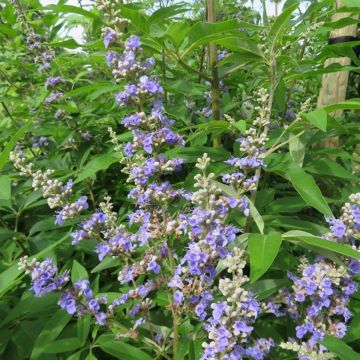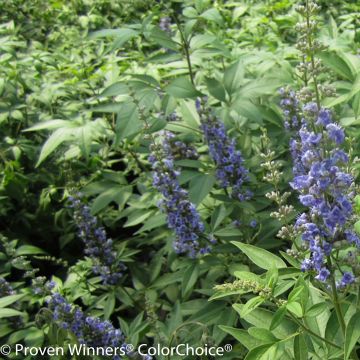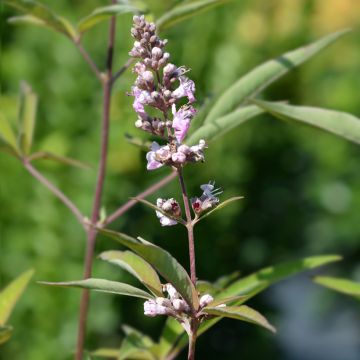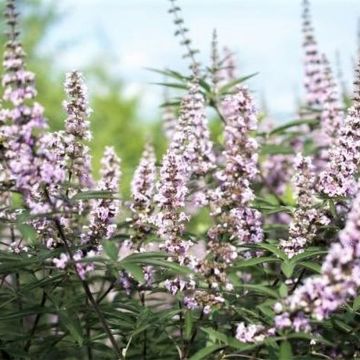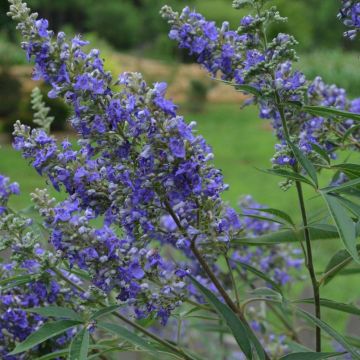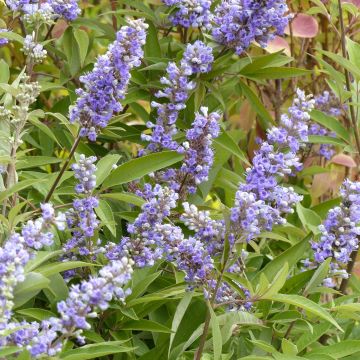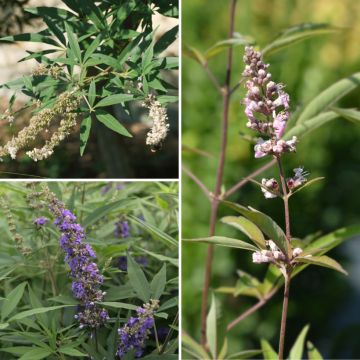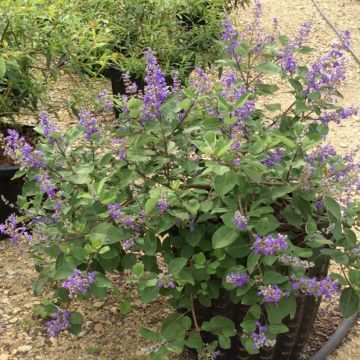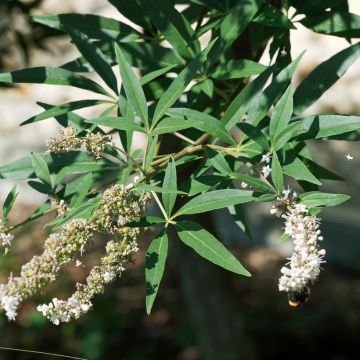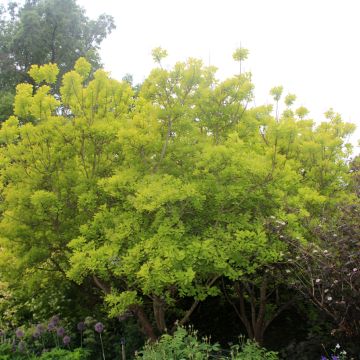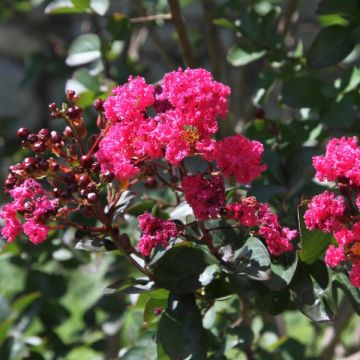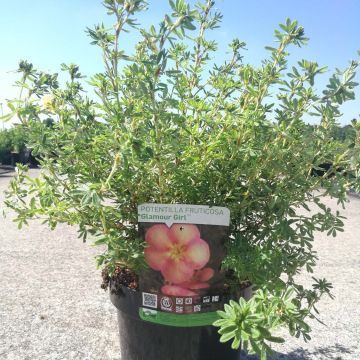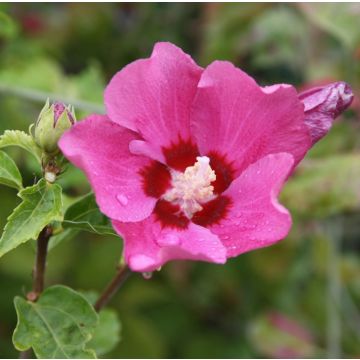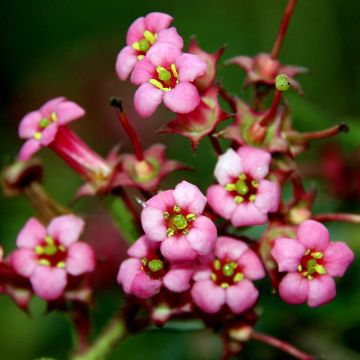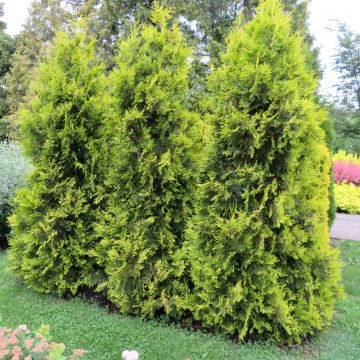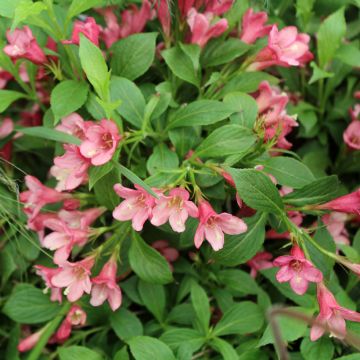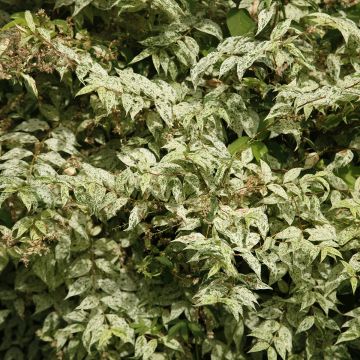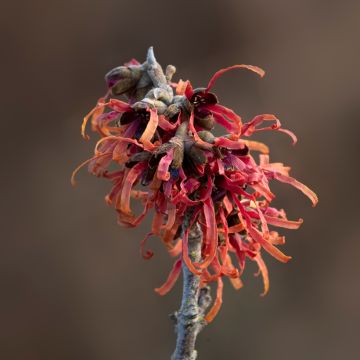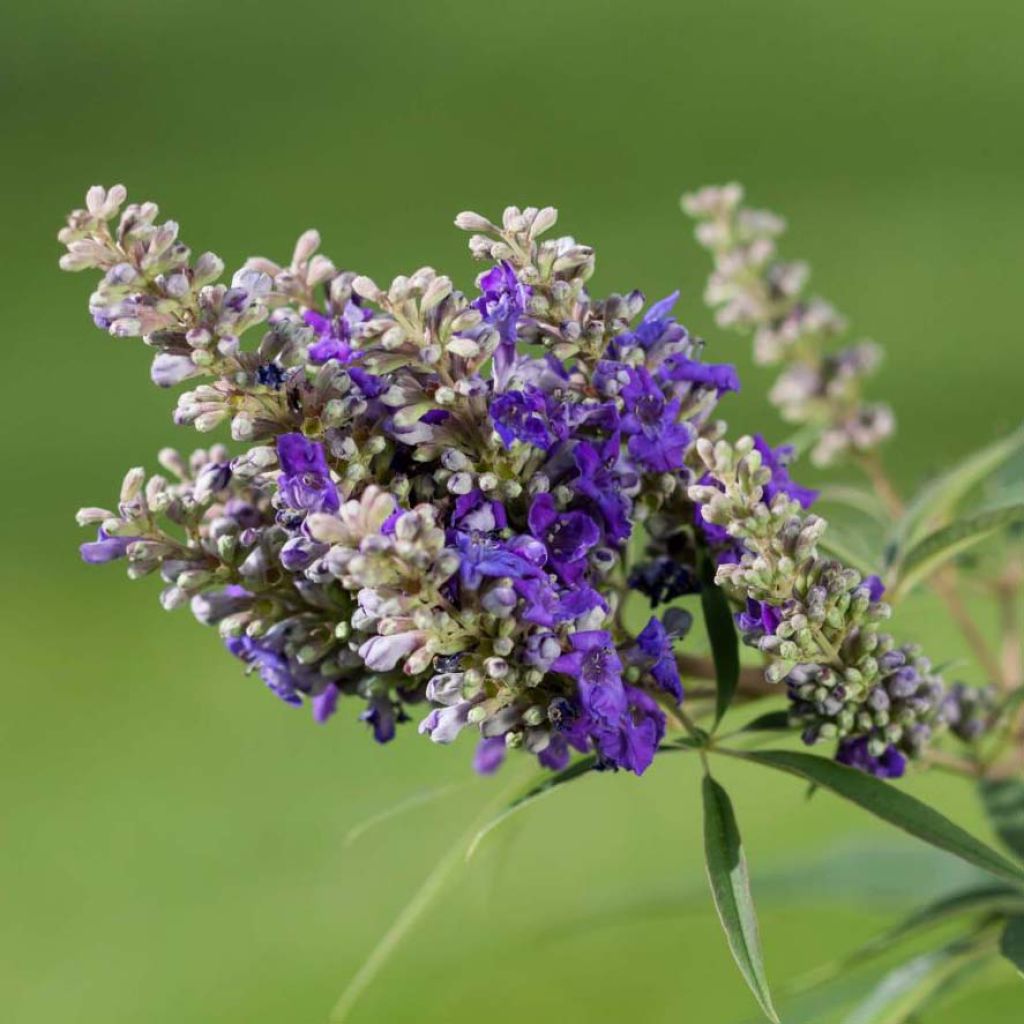

Vitex agnus-castus Blue Puffball - Gattilier
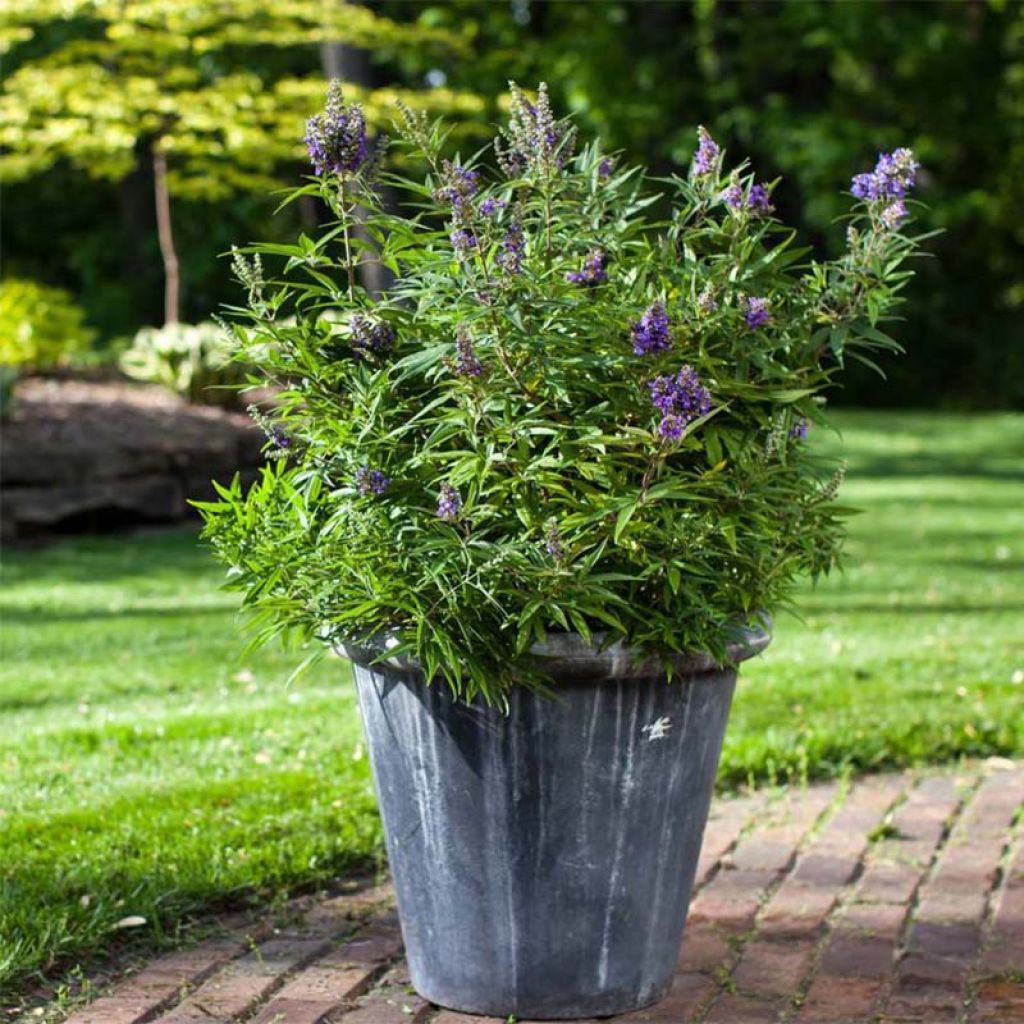

Vitex agnus-castus Blue Puffball - Gattilier
Vitex agnus-castus Blue Puffball - Chaste Tree
Vitex agnus-castus Blue Puffball®
Chaste Tree, Monk's Pepper, Chasteberry, Chaste Lamb
This item cannot be shipped to the selected country
Delivery charge from €5.90
Delivery to Corse prohibited
More information
Schedule delivery date,
and select date in basket
This plant carries a 24 months recovery warranty
More information
We guarantee the quality of our plants for a full growing cycle, and will replace at our expense any plant that fails to recover under normal climatic and planting conditions.
From €5.90 for pickup delivery and €6.90 for home delivery
Express home delivery from €8.90.
Delivery to Corse prohibited: UE law prohibits the import of this plant from mainland France to Corse as part of the fight against Xylella fastidiosa. Please accept our sincere apologies.
More information

Does this plant fit my garden?
Set up your Plantfit profile →
Description
Vitex agnus-castus 'Blue Puffball' is a new variety of Chaste Tree with very compact growth, perfectly suited for small spaces and container gardening. This round-shaped shrub, with no other requirements than a sunny exposure, has more than one advantage: summer flowering with clusters of beautifully deep lavender-blue scented flowers, decorative and aromatic fruiting, beautiful palmate grey-green foliage that emits a fragrance, good cold resistance, and exemplary frugality and sobriety. The list of its qualities would be incomplete if we forget to mention that it tolerates sea spray perfectly and adapts to salty, sandy, poor, or even limestone soils. Objectively, few plants can rival this versatile Vitex, which is ready to make its entrance into any garden.
Vitex agnus-castus is a shrub from the Verbenaceae family, native to the Mediterranean basin and Asia Minor. While it is particularly robust and easy to grow, it is often criticised for its excessive growth, disorderly habit, and lackluster flowering. All these flaws are corrected with this new 'Blue Puffball' variety, which is truly dwarf, obtained recently after years of experimental selection in the United States.
'Blue Puffball' has a very rounded and bushy, compact habit, with gracefully upright branches. When mature, it will measure approximately 1.1 m (4 ft) in all directions. Its flowering takes place from July to September, depending on the climate, on the current year's shoots. Upright spikes, adorned with tiny flowers of a rather dark lavender-blue colour, cover the plant. Then small fruits the size of peppercorns form, which are very aromatic, dark red and shiny, and persist until winter. The fast-growing stems are strong and very flexible. Quite late in spring, these then develop palmate leaves which are divided into 5 slender lobes. The colour of the leaves is a dark greenish-grey, matte, and slightly silvery when they first emerge. The foliage emits a strong peppery scent when crushed, hence its nickname of Pepper Tree. Vitex plants have a very deep root system, which allows them to draw moisture from deep down when the summer is dry. In very cold regions, the above-ground parts of the shrub will be destroyed, without harmful consequences for the plant, which will regrow within a few months and bloom abundantly on its new shoots. The deciduous foliage falls in autumn.
Often found by the coast, sometimes very close to the shore and anchored in the sand between rocks, Vitex agnus-castus withstands drought once well established, much like the Tamarisks with which it gets along well. Having retained the qualities of this undemanding and sturdy shrub, the 'Blue Puffball' variety proves to be more elegant, more brilliant, and easier to use in the garden, even when space is limited. Its modest growth allows it to fit into small perennial beds, in a container on the terrace, in the foreground of a shrub bed. For example, associate it with oleanders (in mild climates), pink repeat-flowering roses (The Fairy), dwarf buddleias, or even a summer-flowering Tamarisk. This shrub with the appearance of a giant blue lupin is superb surrounded by yellow daylilies, shrubby Russian sages, and grasses like Miscanthus Yaku jima, etc.
Its vernacular name of 'Monk's Pepper' dates back to the Middle Ages when some clergymen consumed the berries of the shrub to resist the temptations of the flesh. Since then, studies have proven the plant's properties to relieve problems related to hormonal fluctuations in women. In Ancient Greece, the stems of Vitex were used to make strong bindings. Legend has it that Ulysses used these to tie his companions under the bellies of sheep, allowing them to escape from the Cyclops' cave.
Report an error about the product description
Vitex agnus-castus Blue Puffball - Chaste Tree in pictures
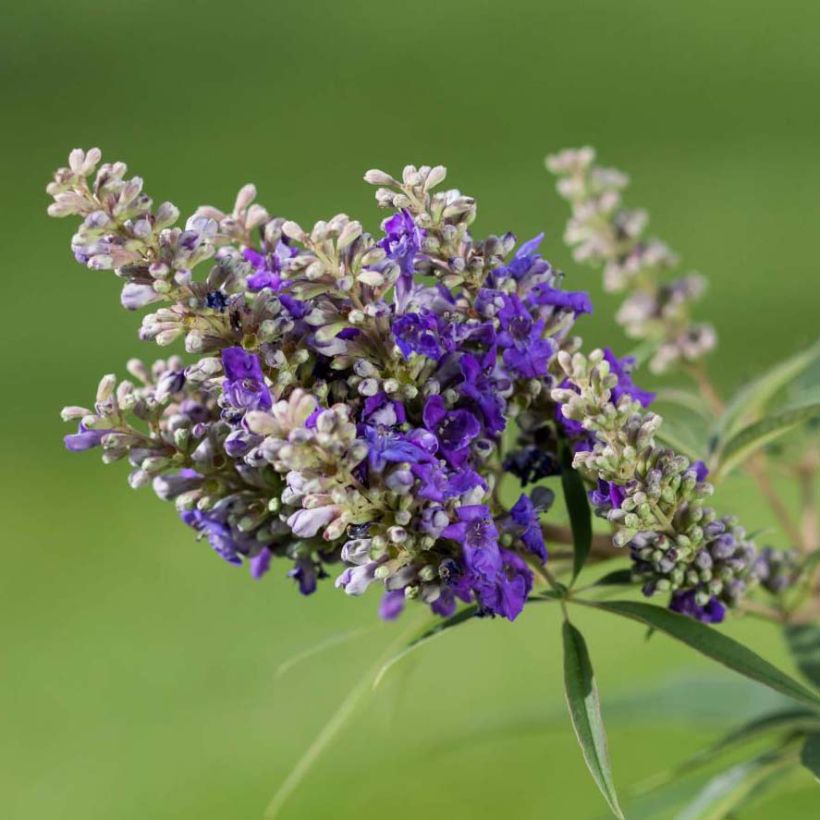

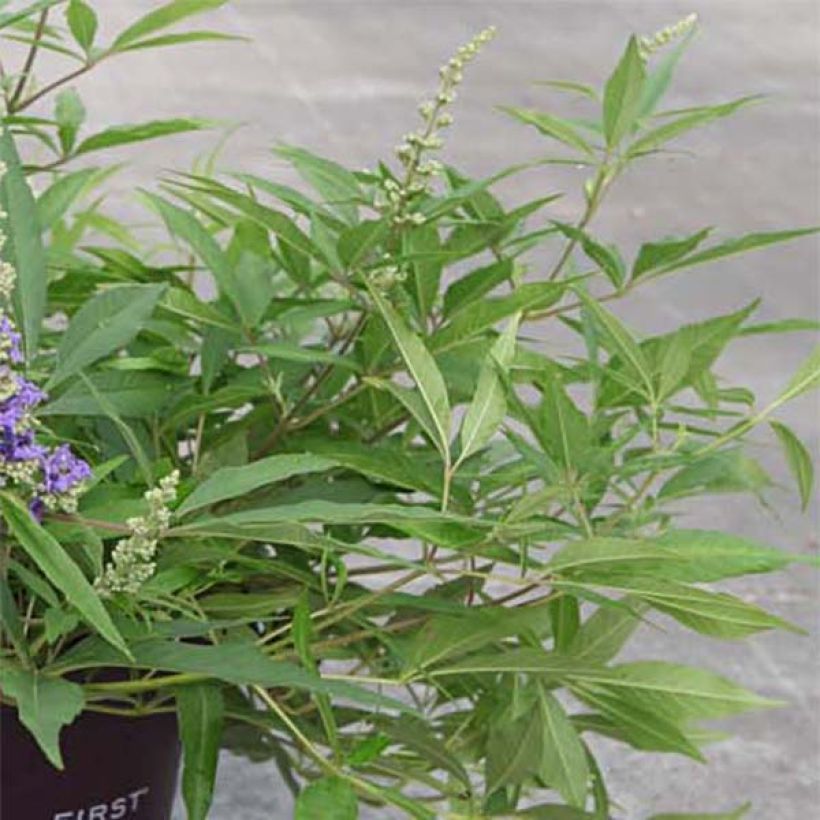

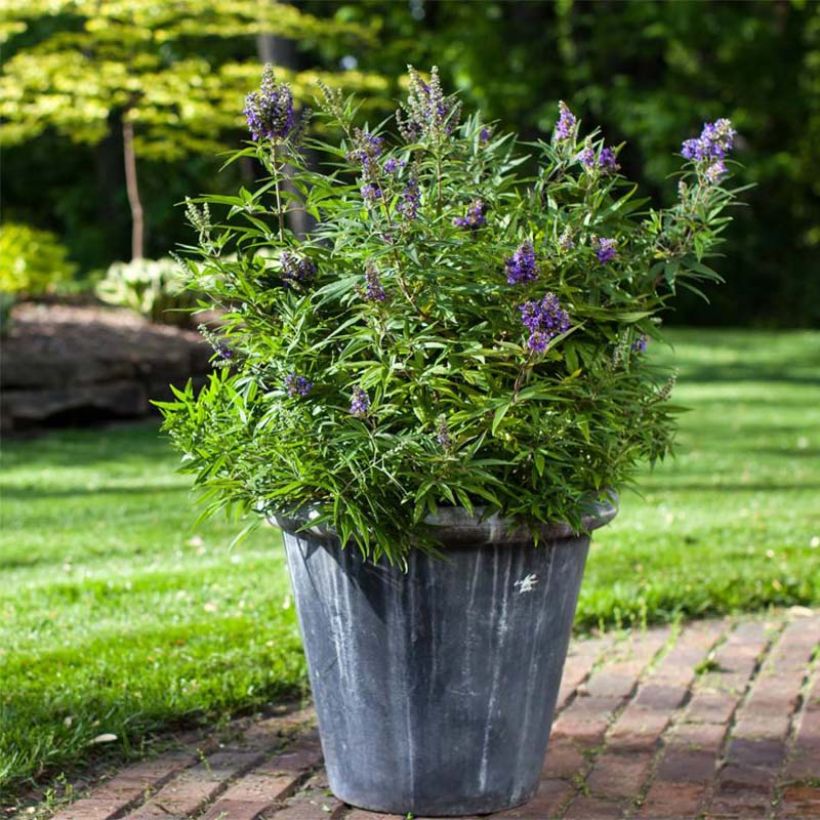

Plant habit
Flowering
Foliage
Botanical data
Vitex
agnus-castus
Blue Puffball®
Verbenaceae
Chaste Tree, Monk's Pepper, Chasteberry, Chaste Lamb
Cultivar or hybrid
Other Vitex - Chaste tree
Planting and care
Plant Vitex in a sunny position in ordinary but well-drained and preferably deep soil. This shrub is not very demanding in terms of the nature of the soil, whether it is limestone, neutral or slightly acidic, sandy, rocky, or clayey (but drained). It withstands sea spray and brackish water well. Shelter it from cold and drying winds and water in case of prolonged drought during the first 2 or 3 years. It fears very strong frosts, especially if the soil in which it is planted is inadequately drained. Its vegetation may be destroyed by severe frosts, but it will regrow from the stump in spring. Pruning is not obligatory, but it promotes a bushy habit: carry out this operation at the end of winter or the beginning of spring. Vitex is not very susceptible to diseases and pests.
Planting period
Intended location
Care
-
, onOrder confirmed
Reply from on Promesse de fleurs
Hedge shrubs
Haven't found what you were looking for?
Hardiness is the lowest winter temperature a plant can endure without suffering serious damage or even dying. However, hardiness is affected by location (a sheltered area, such as a patio), protection (winter cover) and soil type (hardiness is improved by well-drained soil).

Photo Sharing Terms & Conditions
In order to encourage gardeners to interact and share their experiences, Promesse de fleurs offers various media enabling content to be uploaded onto its Site - in particular via the ‘Photo sharing’ module.
The User agrees to refrain from:
- Posting any content that is illegal, prejudicial, insulting, racist, inciteful to hatred, revisionist, contrary to public decency, that infringes on privacy or on the privacy rights of third parties, in particular the publicity rights of persons and goods, intellectual property rights, or the right to privacy.
- Submitting content on behalf of a third party;
- Impersonate the identity of a third party and/or publish any personal information about a third party;
In general, the User undertakes to refrain from any unethical behaviour.
All Content (in particular text, comments, files, images, photos, videos, creative works, etc.), which may be subject to property or intellectual property rights, image or other private rights, shall remain the property of the User, subject to the limited rights granted by the terms of the licence granted by Promesse de fleurs as stated below. Users are at liberty to publish or not to publish such Content on the Site, notably via the ‘Photo Sharing’ facility, and accept that this Content shall be made public and freely accessible, notably on the Internet.
Users further acknowledge, undertake to have ,and guarantee that they hold all necessary rights and permissions to publish such material on the Site, in particular with regard to the legislation in force pertaining to any privacy, property, intellectual property, image, or contractual rights, or rights of any other nature. By publishing such Content on the Site, Users acknowledge accepting full liability as publishers of the Content within the meaning of the law, and grant Promesse de fleurs, free of charge, an inclusive, worldwide licence for the said Content for the entire duration of its publication, including all reproduction, representation, up/downloading, displaying, performing, transmission, and storage rights.
Users also grant permission for their name to be linked to the Content and accept that this link may not always be made available.
By engaging in posting material, Users consent to their Content becoming automatically accessible on the Internet, in particular on other sites and/or blogs and/or web pages of the Promesse de fleurs site, including in particular social pages and the Promesse de fleurs catalogue.
Users may secure the removal of entrusted content free of charge by issuing a simple request via our contact form.
The flowering period indicated on our website applies to countries and regions located in USDA zone 8 (France, the United Kingdom, Ireland, the Netherlands, etc.)
It will vary according to where you live:
- In zones 9 to 10 (Italy, Spain, Greece, etc.), flowering will occur about 2 to 4 weeks earlier.
- In zones 6 to 7 (Germany, Poland, Slovenia, and lower mountainous regions), flowering will be delayed by 2 to 3 weeks.
- In zone 5 (Central Europe, Scandinavia), blooming will be delayed by 3 to 5 weeks.
In temperate climates, pruning of spring-flowering shrubs (forsythia, spireas, etc.) should be done just after flowering.
Pruning of summer-flowering shrubs (Indian Lilac, Perovskia, etc.) can be done in winter or spring.
In cold regions as well as with frost-sensitive plants, avoid pruning too early when severe frosts may still occur.
The planting period indicated on our website applies to countries and regions located in USDA zone 8 (France, United Kingdom, Ireland, Netherlands).
It will vary according to where you live:
- In Mediterranean zones (Marseille, Madrid, Milan, etc.), autumn and winter are the best planting periods.
- In continental zones (Strasbourg, Munich, Vienna, etc.), delay planting by 2 to 3 weeks in spring and bring it forward by 2 to 4 weeks in autumn.
- In mountainous regions (the Alps, Pyrenees, Carpathians, etc.), it is best to plant in late spring (May-June) or late summer (August-September).
The harvesting period indicated on our website applies to countries and regions in USDA zone 8 (France, England, Ireland, the Netherlands).
In colder areas (Scandinavia, Poland, Austria...) fruit and vegetable harvests are likely to be delayed by 3-4 weeks.
In warmer areas (Italy, Spain, Greece, etc.), harvesting will probably take place earlier, depending on weather conditions.
The sowing periods indicated on our website apply to countries and regions within USDA Zone 8 (France, UK, Ireland, Netherlands).
In colder areas (Scandinavia, Poland, Austria...), delay any outdoor sowing by 3-4 weeks, or sow under glass.
In warmer climes (Italy, Spain, Greece, etc.), bring outdoor sowing forward by a few weeks.

































